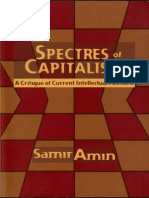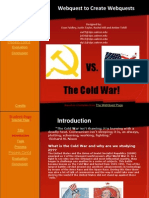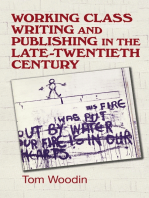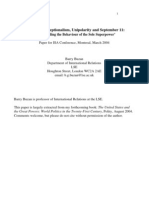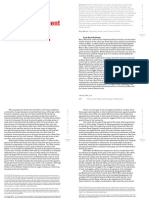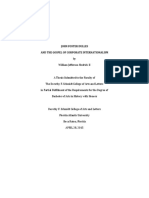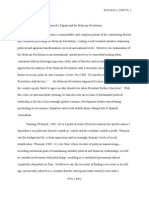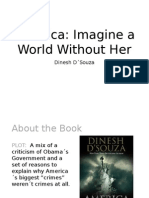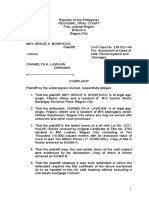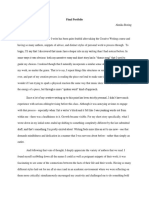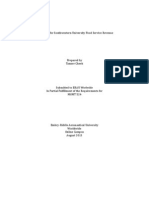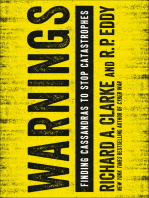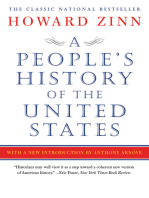Professional Documents
Culture Documents
CH 10, The Cold War in Central America, 1975-1991, John H. Coatsworth
Uploaded by
DeclassifiedMatrixOriginal Title
Copyright
Available Formats
Share this document
Did you find this document useful?
Is this content inappropriate?
Report this DocumentCopyright:
Available Formats
CH 10, The Cold War in Central America, 1975-1991, John H. Coatsworth
Uploaded by
DeclassifiedMatrixCopyright:
Available Formats
CHEN JIAN
and other party elders decided to use troops to crack down. On June 3-4, PLA
soldiers fought their way into the square, attacked the students, and killed an
unknown number of them as well as other Beijing residents. 42 The tragedy of
Tiananmen stunned the entire world.
the rapprochement between Beijing and Moscow ensured that
the tragedy of Tiananmen would be widely covered by the international
media. Gorbachev's official visit to Beijing had attracted extensive media
attention. In addition to reporting on the Sino-Soviet summit, however,
several hundred reporters covered the standoff between the students and
the government, as well as the bloody crackdown on June 3-4. When millions
of viewers in different parts of the world saw on television a young Chinese
man standing in front ofa moving tank to stop its advance, they were shocked.
This was a defining moment for the fall of international Communism.
In China, the Tiananmen tragedy did not put an end to the reform and
opening process. After a short period of stagnation, the refornl process
regained momentum in 1992, when Deng used a dramatic tour of southern
China to revive his refonn ideas and practices. But the Soviet Union and the
Soviet bloc did not survive. In December 1989, the Berlin Wall, which had
existed as the real and symbolic dividing line between East and West for
almost three decades, was destroyed. The same month, Romania's
Communist dictator Ceau~escu and his wife were executed after they tried
but failed to use military force to suppress mass protests in Bucharest. Two
years later, on August 19, 1991, a military coup staged by a group of hard line
Communist leaders occurred in Moscow. However, the coup was quickly
defeated. The coup leaders hesitated to repress the resistance because the
"jarring effect" ofthe Tiananmen tragedy lingered in their minds. 41
then,
became another defining moment in twentieth-century hiStory, a moment
that led to the collapse of the Soviet Union and the entire Communist bloc in
Eastern Europe in a few short months. As a consequence, the global Cold War
ended. Although the conflict started and finished in Europe, the great trans
formations that China experienced from the late [960s to the early 1990S
formed a unique and integral part of the Cold War's final denouement.
42 The Chinese government announced that thirty-six
died on June 3-4. The
unofficial death toll provided by survivors and international observers, however, is
several hundred or more.
43 Por an excellent account of the "abhorrent" memory of the Tiananmen tragedy by the
SOVlCt leaders and its
effect" upon developments in the Soviet Union and East
European countries, see
Kramer, "The Collapse of East European Communism
and the Rcoercussions within the Soviet Union," Journal ofCold War Studies, 5, 4 (2003),
I (2005),66.
33-35; and
200
IO
The Cold War in Central America,
1975-1991
JOHN H. COATSWORTH
The
stalemate that prevented a direct military conflict between
the United States and the Soviet Union displaced violent superpower com
petition to areas of the Third World where the two blocs could invest in
local and regional wars without risking direct confrontation. The Soviet Union
tended to approach such conflicts cautiously even when they involved other
Communist states. I The United States, by contrast, adapted its security policies
to a containment doctrine that defined the political complexion of every non
Communist government in the world as a matter ofpotential strategic interest.
Local Oppo1>1tion to foreign rule in the US and European colonial empires, and
social movements aiming to displace traditional elites elsewhere, confronted
a strong US preference for reliably anti-Communist (and thus conservative
to right-wing) regimes. Even moderate to conservative regimes that sought
to advance national interests by constraining US influence came under assault
from Washington. Governments that collaborated closely with the United
States often had to ignore or suppress local interests opposed to US policies.
In its prosecution of the Cold War in the Third World, the United States
enjoyed formidable advantages over its Soviet rival. Economic strength
gave US leaders a decided financial and material advantage over the Soviets.
Military bases projected US power into regions bordering on Communist
states throughout the world. US ideological and cultural assets also helped.
Alliances with local elites eager to reduce domestic challenges proved espe
helpful. The United States deployed all of these resources in response
to perceived affronts to its regime and policy preferences wherever they
occurred. The Soviet Union and its allies worked assiduously to overcome
for allies and "proxies" in the Third World to avoid
costly and unproductive commitments, In Latin America, for
the Soviets
declined to support gucn-illa movements in the I9608 and
Cubans fc)r
doing so. Sec Jorge Dominguez, To Make a World SaJeJor Revolution: Cuba's Foreign Policy
(Cambridge, MA: Harvard University Press, 1989), ch . .1.
201
JOHN H. COATSWORTH
The Cold War in Central America, 1975-1991
US advantages by supporting anti-US political movements and regimes,
though their successes were fewer and frequently reversible. The US-Soviet
an era of escalating violence throughout the Third Wodd
that did not stop until the Cold War ended with the collapse ofthe Soviet
Union in T99D-9I.2
In Latin America, unlike most other regions, the Cold War projection of
US power was based on its existing strategic and economic predominance.
By World War I, the United States had succeeded either in controlling or
in securing the overthrow of governments deemed unfriendly throughout
Central America and the Caribbean. In the 1920S, US economic and geopolitical
interests extended to most of South America as welL In the 1930S, faced with
growing resentment
its interventions in the Caribbean, which made it
difficult to secure Latin American cooperation in efforts to revive trade after the
collapse of 1929-33, the United States announced a "Good Neighbor" policy,
according to which it would henceforth refrain from direct military interven
tions anywhere in the hemisphere.]
The Cold War provided a convenient rationale for w'~~'6'Ho
tionalizing preexisting US efforts to impose its ideological and
conformity,
ences on other states. As the United States insisted on
however, opposition to its influence often intensified. An early crisis point
occurred in 1959-62 when a newly installed Cuban government opted to
defect to the Soviet camp rather than adjust its policies to US requirements. 4
The Cuban govemment then supported movements opposed to pro-US elites
and regimes throughout the hemisphere. The United States reacted forcefully
between T962 and I973 by intervening to secure the removal ofgovernments it
deemed unsuitable or unreliable. When the left-wing nationalist Sandinista
movement (the Sandinista National Liberation Front,
friendly to Cuba
seized power in Nicaragua in 1979 and armed opposition movements gained
support in EI Salvador and Guatemala, the United States again reacted
strategic or
The Soviet Union, on the other hand, had no
economic interests in the western hemisphere. Soviet leaders refused pleas
for military aid to avert the US attack on Guatemala in I953-54. 5 Though it
provided military and economic aid to Cuba from T96T, the USSR opposed
Cuba's support of guerrilla insurgencies in the 1960s. In the I970s, the Soviets
pushed the Cubans to abandon support for such movements in Latin America,
offered only modest assistance to the elected socialist government of Chile
and sought normal diplomatic and trade relations with the some of
region's most repressive military regimes. 6 The Soviet Union and some East
lEuropean Communist states provided aid to Nicaragua after the victory of
the Sandinista insurgency, but in small amounts reflectine: Soviet economic
decline and political uncertainty.
Latin American governments, political movements, and interest groups
often challenged US predominance from within the region. Though circum
stances and capacities varied, nearly every Latin American government
attempted at one time or another to mitigate or evade compliance with US
interests by turning to other great powers, such as Britain, France, and both
imperial and Nazi Germany. The Cuban appeal to the Soviet Union in the
1960s thus followed a long tradition. At various times, Latin American govern
ments, unsuccessfully for the most part, requested regional or international
support through the Pan American Union or its successor, the Organization
of American States (OAS) , or the United Nations. Some sought to deflect
or resist US pressure by mobilizing popular support, but such mobilizations
raised popular expectations, alienated elites, and often drove the United States
to intervene.
Had the United States limited its Cold War objectives to defense against
threats to its security, it would have had little reason to exert itself in Latin
America. In addition to its unchallenged economic and political predomi
nance, the United States emerged from World War TI with nuclear weapons
and a military establishment immensely superior to any regional power, indeed
more than sufficient to deter any potential threat from Latin America without
compromising other strategic missions. US political leaders, however, tended
to accord great symbolic importance to deviations from US policy preferences
in Latin America, especially in the Caribbean basin. They worried about
the demonstration or domino" effect of any defections from the US camp
on neighboring and even distant countries, but their greatest concern focused
See Human
(New York:
3 On the Good
Center, Human Security Report 2005: War and Peace in the 21St Century
Press, 2005), Part I.
Policy, the classic work is Bryce Wood, The Making of the Good
Neighbor
York: Norton, 1967).
4
chapter in volume II.
On
bloc rejection of Guatemalan aid requests, see Piero Gleijesis, Shattered Hope:
The Guatemalan Revolution and the United States, 1944-1954 (Princeton, Nl: Princeton
University Press, 1991). ch. 9.
2
202
6 On Soviet policy in Latin America in the 19605 and 1970S, see Dominguez, To Make
a World Safr for Revolution, chs. 3-4; Cole Biasier, The Giant's Rival: The USSR and
Latin America (Pittsburgh, PA: University of Pittsburgh Press, 1983); and Nicola Miller,
Soviet Relations with Latin Amerie.a, 1959-1'187 (Cambridge: Cambridge University Press,
1989)
203
JOHN H. COATSWORTH
additional territory "full" to
on the domestic political consequences
"Communism."
The institutional foundations for prosecuting the Cold War in Latin
America developed in the late I940S with the signing of the Inter-American
Treaty of Reciprocal Assistance (or Rio Treaty) in 1947 and the creation of
the OAS in 1948. In addition to pushing for new inter-American institutions, the
us government also abruptly shifted its diplomatic and intelligence agencies
from combating Axis influence in Latin America to fighting Communism. In
the Caribbean and Central
where the United States could overtum
and replace governments with ease, US officials expected a particularly high
degree of conformity to US policy preferences.
The Cuban revolution of 1959 marked a watershed in the Cold War strategy
of the United States in Latin America. After defeating an invasion force
of US-sponsored counterrevolutionaries at the Bay of Pigs in April 1961, the
Castro government received Soviet military aid to bolster its defenses against
what both Cuban and Soviet authorities perceived as the threat of an immi
nent invasion by the armed forces of the United States. The Soviets secretly
placed intermediate-range ballistic missiles with nuclear warheads in Cuba in
September-October I962 and succeeded in extracting from the administration
ofJohn F. Kennedy (1961-63) a pledge not to invade Cuba in exchange for their
withdrawal? The survival of the Cuban revolution and the country's trans
formation into a Communist state allied politically and diplomatically to the
Soviet Union induced major shifts in US policy toward Latin America during
s
the Kennedy and Lyndon B.Johnson
administrations. On the one
hand, the Kennedy administration created an "Alliance for Progress," an aid
program with the goal of demonstrating that non-Communist, democratic
regimes could match the social progress achieved by Communist Cuba.
doctrine to guide military aid that
On the other, it developed a new
emphasized the role of Latin America's armed forces in suppressing
threats to the established order rather than defending the
against external invasion. These threats included not
guerrilla movements, which erupted in the
governments that drifted leftward or otherwise failed to conform to US
requirements.
7 See James G. Ilershberg's chapter in volume II.
The Cold War in Central America, 1975-1991
The Carter administration and human rights
in Central America
When Jimmy Carter assumed the US presidency in January 1977, only
Venezuela, Costa Rica, and Colombia in Latin America had governments
voted into office in open, competitive elections. The new US administration,
spurred by public, congressional, and international criticisms of the policies
of Richard M. Nixon (1969-74) and Gerald R. Ford (1974-77) in Latin America,
made human rights the centerpiece of its Latin American policy. To the
consternation of the region's military
the US government suddenly
became critical of the measures they saw as necessary to eliminate Communist
and left-wing influence. President Carter endorsed the conventional view,
often at odds with official US actions in the 19605 and 1970S, that the lack of
democracy threatened the stability of the
in the long run. He saw
dictatorships as inherently unstable and worried that the opposition move
ments they provoked would follow the path of the Cuban revolution toward
radicalization and eventual alliance with the USSR. Some Carter officials
thus began pressuring the
to cede power to elected governments
and cease abusing citizens during the transition.
others in the
Carter administration worried that abruptly withdrawing support from
military regimes would create the very instabilitv that Carter claimed he
wanted to avoid. 9
The Carter administration began in I977 to
its human rights
policies in Central America, though it gave initial priority to renegotiating the
Only Costa Rica, of the five Central American repub
t:lt:cnons, respected the civic and human rights ofits citizens,
and provided public goods and services (education, health, infrastructure)
with reasonable efficiency and transparency. In Honduras, the Carter admin
istration succeeded in improving human rights by supporting democratically
inclined military officers who eventually engineered the country's return
to civilian rule with elections to a constituent assembly in 1980. It failed
in Guatemala and EI Salvador, however, where human rights abuses were
escalating and neither government showed the slightest interest in negotiating
with the United States. Carter cut off military aid to both these countries in
1977, In response, these governments ended military ties to the United States
8 Despite Cuba's repeated expressions of interest, tbe USSR never entered into a formal
alliance with Cuba nor did it
agree to defend Cuba militarily. Cuba
was not a member of the Warsaw Pact.
9 For a useful and insightful review of Jimmy Carter's human rights
and their
implementation in Latin America as a whole, see Kathryn Sikkink,
SignaLI: US
Human Rights Policy and Latin America (Ithaca, NY: Cornell university Press, 2(04), ch. 6.
204
205
The Cold War in Central America, 1975--1991
JOHN H. COATSWORTH
and denounced the Carter policy as intrusive meddling in their internal affairs.
The US government continued economic aid to avoid punishing innocent
beneficiaries, and sought quietly to develop contacts and leverage within the
two military establishments. This backdoor military diplomacy succeeded
in EI Salvador in 1979, but failed in Guatemala.
Carter focused most of his attention on Nicaragua, in part because the
regime of Anastasio Somoza seemed most likely to bend to US pressure. In
1978, Somoza's rivals began to pose a threat to the government, making
it potentially more dependent on US help. When the country exploded in
mass protests and insurrection in September, Carter was already pressuring
President Somoza to cede power to a new government that would organize
elections. Ifmanaged adroitly, Somoza's government could then be replaced
by one dominated by one or another of the country's traditionally moderate
political parties, grateful to the United States for having paved its way to
power. The alternative, which Carter and his advisers sought to avoid, was a
polarization ofNicaragua into warring camps, with the initiative passing to the
armed guerrillas of the Sandinista National Liberation Front. Somoza, on the
other hand, was determined to retain power and convinced that, if the United
States were forced to choose between him and the FSLN "Communists," it
1O
would have to choose him and back off from its efforts to push him out.
Events moved more rapidly than either Carter or Somoza anticipated.
Somoza maneuvered to elude demands for "free elections" and began elim
inating plausible alternatives. On january 10, 1978, the assassination of Pedro
joaquin Chamorro, the wealthy publisher of the opposition newspaper La
Pren.sa and a possible successor, touched off a general strike. FSLN guerrillas
gained adherents throughout the country. Urban attacks and even large-scale
uprisings against the National Guard multiplied. The FSLN managed to seize
the national Congress building in Managua in August. The following month,
the FSLN briefly seized the northern town of Esteli, buoyed by a mass
insurrection against the regime. In December, Somoza rejected a last effort
by the Carter team to negotiate a peaceful departure.
Between january and June r979 , the Carter administration watched as the
FSLN and Somoza's National Guard fought one another. US military
economic aid to the Somoza government was formally cut off in February.
10 Robert A. Pastor. Not Condemned to Repetition: The United States and
,2nd ed.
(Boulder, co: Westview, 2002), chs. 4-<>; Thomas Walker, Nicaragua,
Land
Sanditlo (Boulder, CO: Westview, 1981); William LeoGrande, OUf Own Backyard:
United States and Central America, 1977-1992 (Chapel Hill, NC: University of North
Carc>lina, 1998), 10-32.
206
J2. Jubilant Sandinista rebels in the main square
seized Managua with huge popular support.
Managua, June, I979. The Sandinistas
and Carter officials hoped Somoza would step down. In late june, after the
OAS rejected a US plan to send "peacekeepers" to Nicaragua because their
main effect would have been to save the National Guard from defeat, US
officials opened negotiations with the FSLN, insisting that the Sandinista
leaders agree to appoint "moderates" to a majority of Cabinet posts in the
new government and promise to hold free elections. The FSI,N agreed after
some hard bargaining, Somoza then fled Nicaragua onjuIYI7; two days
11
the Sandinistas entered Managua amid tumultuous celebrations.
As the Carter administration worked to salvage the wreckage of its anti
Sandinista policies in Nicaragua, it moved simultaneously to avert "another
Nicaragua" in neighboring EI Salvador. It did so by inspiring key officers in
the Salvadoran armed forces to overthrow the highly repressive government
of General Humberto Romero on October 15, 1979. The new government
created a five-person junta or council to exercise presidential powers until
reforms could be implemented and elections called. Two members of the
junta represented the armed forces; three were civilians. The government
Not Condemned, chs. 4-6; Lawrence Pezzullo and Ralph Pezzullo, At the Fall of
Somoza (Pittsburgh, PA: University of Pittsburgh Press, 1993).
II Pastor.
207
The Cold War in Central America,
JOHN H. COATSWORTH
alIDounced an end to repression, full restoration of civic and human rights, and
a commitment to agrarian reform and other progressive social policies. For
the next three months, El Salvador exploded into renewed political activity
and social activism. Political parties, labor unions, community and civic
organizations, church groups, and publications of all kinds suddenly emerged
from hiding or developed spontaneously. Tragically, the junta never managed
to exert control over the Salvadoran military and its repressive appararus
and was not supported by the United States when it sought to do so. The
Salvadoran military and police units remained intact and crushed their foes.
On January 3 and 4, 1980, the three civilian members of the Salvadoran junta
and all the civilian members of the Cabinet resigned in protest. In the months
that followed, the Salvadoran civil war began in earnest. The Carter admin
istration wanted democracy in EI Salvador, but it gave priority to preserving
the integrity of the Salvadoran military and its command structure to avoid
repeating a collapse similar to that of Somoza's National Guard.
The election of Ronald Reagan in November 1980 hastened the collapse
of Carter's efforts. In El Salvador, Reagan's campaign speeches criticizing
Carter's human rights policies had helped persuade the Salvadoran military
to launch an orgy of repression. In December I980, after the rape and murder
of four US nuns, Carter briefly suspended military aid, but this decision had
no impact on the Salvadoran military because its leaders correctly expected
Reagan to reverse it.
In Nicaragua, Reagan's campaign rhetoric, which portrayed the Sandinistas
in Nicaragua as "Communists" and included pledges to remove them from
power, convinced the movement's leaders that there was little point in
placating the United States any longer. US-backed politicians in the Sandinista
Cabinet lost what leverage they had earlier acquired. More significantly,
FSLN leaders decided to extend military and financial aid to the Farabundo
Marti National Liberation Front (FMLN) fighting against the Salvadoran
The FMLN had the support of nearly all the opposition parties
and organizations in El Salvador, except for a minority faction of the
Christian Democrats, whose leaders had agreed to form a new government
with US support. The Sandinistas hoped that the FMLN would be able to
take power in a "final offensive" scheduled for January 198r, just prior to
Reagan's inauguration. They hoped that two revolutionary governments in
1975-1'i91
12
13. Funeral of Archbishop 6scar Romero orEl Salvador. who was killed by right-'WinO'C'r<
in March 1980 as he was saying mass. A bombing at the fi.meralleft thirty-eight
dead, and the civil war intensified.
Central America would be able to withstand the
of the new US
administration better than one. When the FMLN's final offensive failed, the
Sandinistas stopped the flow of weapons and support, but this did not
impress Reagan and his aides. '3
13
12 LeoGrande. Our Own Backyard, 33-51; Pastor, Not Condemned. ch. n; James Dunkerley.
Power in the Isthmus: A Political History o{ Modern Central America (New York: Verso.
T988), ch. 8.
208
See LeoGrande, Our Own Backyar.1; Americas Watch and the American Civil Liberties
Union, Report on Human Rights in El Salvador, January 1982 (Washington, DC: American
Civil Liberties Union. 1082): Cynthia Amson. E! Salvador: A RITo/ulion Confronts the
United States !Washington. DC: Institute for Policy Smdies. 1982).
209
The Cold War in Central America, 1975-1991
JOHN H. COATSWORTH
and human rights. They did adopt a new constitution that called
for open and competitive elections in 1985, which they moved to 1984 in
response to US demands. Nor did the Sandinista regime pose the slightest
military or strategic threat to the United States. The Sandinistas announced
that their country would remain in the OAS and continue to fulfill its obligations
under the Rio Treaty. They stated repeatedly that they would never permit
foreign (i.e., Cuban or Soviet) military bases on their territory and offered to
sign a treaty, with stringent inspection provisions, to that effea, though they did
accept substantial economic and military aid from both.
Throughout the 1980s, both Cuba and the Soviet Union pressured the
Sandinistas to seek an accommodation with the United States and made it
clear that they were not in a position to offer either military proteaion or
sufficient economic aid to subsidize the Nicaraguan economy in the event
that the Sandinistas wished to impose a socialist model. Soviet military aid
totaled a mere $12 million from 1979 through 1980, rising to $45 million in 1981
after the United States began funding exile groups, eventually called the
Contras, that were seeking to create a military force to carry out attacks against
the Sandinista armed forces from bases in neighboring Honduras. Military aid
from all the Soviet bloc countries peaked at approximately $2,50 million in 1984.
Economic aid from the Soviet bloc rose to a high of $253 million in T982 and
declined thereafter. T5 The Sandinista government received more aid
from Western Europe and other Latin American countries than from the
Communist bloc, virtually all of it conditional on respea for private property
and civil liberties. 16
To President Reagan, however, the Sandinistas were implacable enemies
of the United States and had to be overthrown. In March 1981, after less than
two months in office, he authorized the US Central Intelligence Agency (CIA)
to support the Contras. By December, the president had authorized the CIA
to provide them with funds, training, equipment, and logistical support. The
aV1C
The Reagan revolution versus the
Sandinista revolution
In its first weeks in office, the new administration made clear that it intended
to reverse a "dangerous decline" in US power vis-a-vis the Soviet Union and
its allies. The Reagan team charged that timid policies had caused the '10ss"
of Mghanistan, Angola, Ethiopia, Grenada, Iran, Mozambique, and Nicaragua
to hostile regimes. They wanted to support allies and punish foes. Central
America's proximity and weakness made it an ideal test case for their bold
plans. Democracy and human rights would continue to be important goals
in the rhetoric of US officials, but quickly became secondary concerns in
practice. The new administration set about repairing relations with abusive
but pro-US regimes throughout the hemisphere, including the Argentine
military junta whose members were later prosecuted, and the military govern
ment of Guatemala, then in the process of razing hundreds of indigenous
villages and exterminating their inhabitants. T4
The administration's chief policy goals in Central America included the
destruction of the Sandinista regime in Nicaragua and viaory over insurgents
in EI Salvador and Guatemala. It expected Honduras, Costa Rica, and Panama
to help achieve these objectives and exerted unremitting pressure on their
governments whenever their enthusiasm for US efforts flagged.
President Reagan made Nicaragua a key symbol of his administration's
aggressively anti-Communist foreign policy. Nicaragua under the Sandinistas,
the president stated, had become a "Communist," "totalitarian" state similar
to Cuba. BetweenJanuary 1981 and December 1983, the administration orches
trated a step-by-step escalation of tensions with Nicaragua, seeking to build
public support for an eventual US military intervention. The 1984 US presi
dential campaign forced the administration to reverse course to avoid political
setbacks, but after the president's reelection in November, Reagan and his
advisers expected to resume and consummate its campaign to rid the hemi
sphere of the Sandinista regime.
The Reagan administration's hostility toward the Nicaraguan government
stemmed from inaccurate premises. The Sandinistas were not turning Nicaragua
into a "totalitarian dungeon," as Reagan described it. They did not impose
a one-party state, nationalize the country's productive property, or suspend
eI Esdarecimiento Hist6rico, Guatemala, Memory of Si/eIlCC (Tz'inil
na'tab'al): Report of the Commission for Historical Clarification, ::md ed. (Guatemala:
I4 Comisi6n para
Comisi6n para cl Esclarecimienro Hist6rico, 1998).
210
15 On Soviet aid, see "Latin Focus: Despite Fears of US, Soviet Aid to Nicaragua Appears
to Be Limited - While House Will Push To Aid Contras to Lessen Risk of Region
Revolution Managua Shuos Puppet Role," Wall Street Journal, April 3, 1985, 1; Stephen
Kinzer, "For Nicaragua, Soviet Frugality Starts to Pinch," New Yark Times, August 20, 1987;
W. Raymond Duncan, "Soviet Interests in Latin America: New Opportunities and Old
Constraints, 'Journal of Inter-American Studies and Warld Affairs, 26,2 (May 1984), 163--98.
16 On the Sandinista regime, see Thomas Walker, Revolution and Counterrevolution in
Nicaragua (Boulder, CO: Westview, 199I), and Stephen Kinzer, Blood of Brothers: Life
and War in Nicaragua (New York: G. p, Putnam, 1991). On Soviet policies and attitudes,
see Kiva Maidanik, "On Real Soviet Policy Toward Central America," in Wayne
S. Smith (cd.), The Russians Aren't Coming: New Soviet Policy in Latin America (Boulder.
CO: Lynne Rienner, 1992), 89-96.
211
JOHN H. COATSWORTH
The Cold Warin Central America, 1975-1991
Honduran government essentially ceded control of its border with Nicaragua
to the CIA and its Nicaraguan recruits (initially drawn from the ranks of
the former Somocista National Guard). The Argentine military regime man
aged to spare enough officers from its domestic campaign of terror to
provide appropriate training for the new Contra forces in 1981 and 1982. The
Honduran military also provided logistical support and training. The initial
Contra force of 500 grew to an army of 15,000 at its maximum strength in the
late 198 05. '7
The first major Contra attack on Nicaraguan territory occurred on March
14, 1982. For Reagan, the beginning of the Contra war brought two benefits.
First, it demonstrated the president's resolve. This helped to reduce squab
bling within the administration, weakened those who preferred diplomacy,
and gave notice to other countries in the re,!,Tion (including those supporting
the Sandinistas, such as Mexico and Venezuela) that efforts to negotiate a
solution to the US-Nicaraguan conflict were likely to be futile. Second, the
Contra attacks had a predictably galvanizing effect on the Sandinistas them
selves, In response, the regime declared a state of siege, imposed restrictions
on the press and on civil liberties, and instituted universal military conscrip
tion. These measures gave the Reagan administration the evidence needed to
back its claims about the Sandinistas' totalitarian procliVities. Reagan did not
want to tame the Sandinistas; he wanted them ousted from power.
Though he succeeded, temporarily as it turned out, in creating the monster
he wanted to slay, Reagan faced a skeptical public and Congress. Initially, his
administration had funded the Contras with money already appropriated for
the CIA and the Defense Department. When these funds ran out, it had asked
Congress for additional money. Wary legislators had approved $19 million for
Contra aid in 1983-84, but had prohibited the administration from using any
funds for overthrowing the government of Nicaragua, activities that might be
defined as state-sponsored terrorism under international law. In late 1983, as
polls had showed that public disapproval of the administration's Central
American policies could affect the president's reelection effort, administration
officials had begun speaking in encouraging terms about prospects for a
peaceful resolution of differences with the Sandinistas. ,;,
During the 1984 presidential campaign, Reagan's Nicaragua policy collapsed
into incoherence. Some of the president's advisers used the pause in rhetorical
hostilities to push for a negotiated settlement. In June, Secretary ofState George
Shultz, who had kept himself aloof (or had been excluded) from dealing with
Central American issues, spent two and a half hours at the Managua airport
talking with Sandinista leader Daniel Ortega. Some military leaders in the
Pentagon worried that an invasion of Nicaragua might lead to a protracted
intervention, with the population supporting Sandinista guerrillas, much as
had happened in Vietnam between 1965 and 1975. But the hawks in the CIA
and the White House sought to evade the growing restrictions on aid to the
Contras. They tried to secure funds from private donors and from several
countries closely allied to the United States, such as Israel and Taiwan. They
also approved the mining of Nicaraguan harbors (a flagrant violation of US law
and treaty obligations as well as international law) and supported other acts of
terrorism against civilian targets in Nicaragua, just as press reports began linking
the Contras to human rights abuses, corruption, and drug-smuggling. Angered,
Congress then voted to cut off all aid to the Contras.'9 But some White House
aides again secredy ignored the new restrictions and intensified their campaign
to raise funds for the Contras, an effort led by National Security Council staff
officer Colonel Oliver North.20
The most serious threat to the hawks in the administration came from
the Sandinistas themselves, who adopted a democratic Constitution, moved
national elections to coincide with the US elections in November 1984, lifted
restrictions on the press and on civil liberties, and agreed to permit all opposition
parties, even those supporting the Contras, to run candidates and campaign
freely. The Sandinistas also agreed to sign a "Central American Peace Treaty,"
drafted to meet us requirements and brokered by Costa Rica, Mexico, Panama,
and Venezuela (the Contadora Group), The treaty prOvided for internal democ
racy, a pledge not to support the Salvadoran guerrillas, the withdrawal of all
Soviet bloc and Cuban advisers, a promise never to pemrit foreign military bases
on Nicaraguan territory, limits on the size of its military establishment, and an
independent and intrusive inspection system to ensure compliance. Thereafter,
the Sandinistas kept their pledge not to aid the FMLN in El Salvador and
expelled some of its leaders from Nicaragua. The Sandinistas also asked most
of their Cuban and Soviet bloc military advisers to leave. Although these were
exaL1:ly the steps urged upon the Nicaraguan leaders by Secretary ofState Shultz,
On the congressional debates and restrictions, see Cynrhia Amson, Crossroads: Congress,
the President, and Central America, 1976--1993 (University Park, PA: Penn State University
Press, T993).
20 The illegal White House activities erupted into public view in 1986 in what came to be
known as the Irang-ate or [ran Contra scandal (see n. 23).
19
I7 Christopher Dickey, With the Contras (New York: Simon & Schuster. T987):
BaMM Diplomacy: The Making of American Policy in Nicaragua, 198H9X,
Simon & Schuster. N8S): LeoGrande. Our Own fiackvard eh. TJ.
2T2
Gutman.
York:
213
JOHN H. COATSWORTH
the hawks in the Reagan administration - North, CIA deputy director Roben
Gates, and others - maneuvered to get Honduras to reject the treaty and to
persuade the Costa Rican and Salvadoran governments to express reservations. 21
After the reelection of President Reagan, the campaign to overturn the
Sandinista regime resumed immediately.22 Momentarily cowed by the mag
nitude of the Reagan electoral triumph, CongTess appropriated $27 million in
"non-lethal" aid for the Contras in 1985-86 and then appropriated $mo million
million for weapons) for 1986--87. Despite their new weapons, however,
the Contras did not become an effective military force. More at home in their
well-stocked Honduran base camps than in combat, they suffered a series of
defeats in engagements with the Sandinista army in 1984-85 and subsequently
reverted to terrorist attacks on civilian targets, such as sugar mills, farm
cooperatives, rural schools, and health clinics, most of which were defended,
if at all, by lightly armed civilian militias.
The Reagan administration's illegal activities in supplying arms to the
Contras came to light in a series of incidents that culminated in October and
November 1986. In October, the Nicaraguans shot down a CIA resupply plane
and captured a surviving crewmember, who confessed fully; the Sandinistas
released him. In November, news began leaking from the Middle
East of a secret deal with Iran, in which, among other things, the adminis
tration agTeed to sell arms to Iran and use the "profits" to acquire black-market
arms for the Contras. 23
In addition to breaking domestic laws, the Reagan administration found
itself accused of violating international law by the Nicaraguan government
before the International Court ofJustice in The Hague. Since the violations,
which included the CIA mining of Nicaraguan harbors, could not be denied,
the US government asserted that for reasons of national security it would
no longer accept the jurisdiction of the International Court in matters
relating to Central America. When the court rejected this argument and
rendered a verdict requiring the United States to pay reparations to
Nicaragua for the damages it had inflicted, the United States ignored the
court's ruling. 24
21 LcoGrandc, Our Own Backyard, chs. 15-16; for a contrary view. see Susan Kaufinan
Purcell, "Demystifying Contadora," Foreign Affairs (Fall 1985), 74-95.
22 See, for example. Gaddis Smith, The Last Years of the Monroe Doctrine, 1945-1993 (New
York: Hill & Wang, 1994), 200-01.
23 On the lrangate or Iran-Contra scandal, see Peter Kornbluh and Malcolm Byrne (cds.),
TIle lran--Contra Scandal: The Declassified History (New York: New Press,
24 Smith, The Last Years, 197-99.
214
The Cold War in Central America, 1975-1991
When Republicans lost control of the US Senate in the November 1986
elections and the Iran-Contra scandal erupted two weeks later, public support
for the administration's Nicaragua policy disappeared. The administration
held on to its goal of overthrowing the Sandinistas throughout the fall of
1986 and the spring of 1987 because it still had the funds to do so. When it
became clear in the summer of 1987 that Congress would not allow the Contra
war to continue into the next fiscal year, the administration's Nicaragua policy
disintegTated. In August, the president proposed a plan to House speaker
Wright that specified the conditions under which the US government
would be willing to end its confrontation with the Sandinista regime. Wright
agreed with much fanfare, but then adroitly announced that Reagan's con
ditions coincided with terms already negotiated among the Central American
countries in talks initiated and led by Costa Rican president Oscar Arias. Called
the "Esquipulas II" agreement. named for the Guatemalan town where the
treaty was negotiated (an Esquipulas I agreement had not prospered), the
treaty accomplished what the Reagan team had sought to avoid: it provided
a mechanism for ending the Contra war without the disappearance of the
Sandinista government. Reagan objected and bitterly opposed the Esquipulas
II agTeement, but the disarray in his administration due to the Irani Contra
scandal, together with congressional and public opposition to his Central
American policies, left him little room to maneuver.25
In fact, the Esquipulas II agTeement embodied virtually all US demands
except for the overthrow of the Sandinista government. It required the
Sandinistas to place Nicaragua's internal politics under international super
vision, to hold new elections (already scheduled) but without restrictions on
foreign financing of electoral campaigns, and to negotiate separately with the
Contras. The Sandinistas agreed to these terms, despite their risks, because
the Contra war had devastated the Nicaraguan economy, forced the govern
ment to abandon most of the social programs it had begun to implement,
and cost the lives of 30,000 Nicaraguans, mostly civilian supponers of the
Sandinista revolution. Though the Reagan administration had failed to over
throw the Sandinistas and found itself forced to accept a peace process it had
bitterly opposed, the Contra War and the election of Reagan's vice preSident,
2.5 On negotiating with the crippled Reagan team, see Jim Wright, Worth ItA!l: My War for
Peace (Washington, DC: Brassey's, 1993). On the peace agreement, for which Oscar
Arias was awarded the Nobel Peace Prize in J987, sec Martha Honey, Hostile Acts: US
Policy in. Costa Rica in the 1980 (Gainesville, FL: University Press of Florida. 1994), ch. 14;
LeoGrande, Our Own Backyard, ch. 21; John M. Barry, The Ambition and the Power (New
York: Viking, 1989).
215
JOHN H. COATSWORTH
George H. W. Bush, to the presidency in 1988 persuaded most Nicaraguans that
their country had no choice but to install leaders that Washington would
approve. The Sandini~tas lost the election of 1990 to a US-organized and -financed
26
coalition of anti-Sandinista parties.
Counterinsurgency in Guatemala and El Salvador
In Guatemala and El Salvador, the Reagan administration supported the
counterinsurgency campaigns of the local militaries. The Guatemalan guer
rilla movement had revived in the mid-1970s, attracting widespread support in
the indigenous communities ofthe highland provinces. Afflicted by economic
change, increasing inequality, and generational conflicts, and nurtured by the
growing presence of outsiders (Catholic Action, evangelical missionaries, and
Peace Corps volunteers), many indigenous communities sought new ways
to resolve tensions. National governments, which had once kept the peace
by maintaining clientelistic relations with indigenous leaders, were not so
good at managing these relationships when they were controlled by military
leaders. Pervasive neglect punctuated by episodes of repression replaced the
old system. 27 The guerrillas recruited the young, the energetic, and
seeking democracy or social justice, but also developed ties to traditional
community leaders who had lost faith in the government. By 198r, 17,000
soldiers of the Guatemalan army faced 6,000 insurgents organized into seven
fronts nominally covering two-thirds of the nation's territory; the guerrillas
occupied one provincial capital and dozens of highland villages.28
The Reagan administration sought to renew military aid to Guatemala,
hut failed to persuade Democrats to go along. Massive human rights abuses,
which the administration denied, troubled even some Republicans in Congress.
Although the Guatemalan army circumvented the cutoff by purchasing
weapons from other countries, the Reagan administration still fretted about
the regional implications ofguerrilla successes in Guatemala and looked for
an opportunity to help reverse them. When dissident military commanders
overthrew Guatemalan president Lucas Garcia and installed former general
26 John H. Coatsworth, Centra! America and the United States: The Clients and the Colossus
(New York: Twayne, 1994), 166.
27 See Greg Grandin, The Blood of Guatema!a: A History ~fRace and Nation (Durham, NC:
Duke University Press. 2000). 220-33.
Peralta. 'The Hidden War: Guatemala's Counterinsurgency
Nora Hamilton, Jeffrey A. Frieden, Linda Fuller. and Manuel Pastor,
Jr.. Crisis in Central America: Re~onal Dynamics and US Policy in the 19805 (Boulder, CO:
Westview. 1988), 153-82.
28 Gabriel AlrUilcra
2I6
The Cold War in Central America, 1975-1991
Efrain Rios Montt, a recent convert to evangelical Protestantism, Reagan
renewed economic aid. In December 1982, he visited Guatemala City,
praised the new government's commitment to defending Guatemala
from the threat of Communism, and promised to renew US military aid.
The Rios Montt government acted decisively. In 1982 and 1983, it destroyed
an estimated 686 indigenous villages and hamlets, killing between 50,000 and
75,000 people. It forced 800,000 peasants into "civil patrols," sparing their
communities only ifthey prOVided evidence oftheir success in uncovering and
killing insurgents. In a population offewer than 9 million, the regime created a
million refugees (150,000 of whom f1ed into Mexico).29
Rios Montt was toppled by a new coup in August 1983. The new govern
ment, headed by General Oscar Mejia Victores, consolidated the gains
achieved
the insurgents. He ended Rios Montt's quixotic but popular
campaign against corruption, rescinded tax increases to which the nation's
economic elite had objected strenuously, and promised to return the country
to civilian rule. The Reagan team welcomed the government's pledge to hold
new elec'tions because it provided evidence of the regime's commitment
to democracy at a time when credible reports of atrocities were f100ding
Congress and the media. On the other hand, the new regime refused to be
drawn into US efforts to contain Communism in the rest of Central America.
Mejia Victores declared that "the countries of the isthmus could coexist with a
Communist Nicaragua. "3 His civilian successors encouraged negotiations and
compromise.
the insurgency in EI Salvador proved to be the Reagan admin
istration's most difficult challenge in Central America. The Salvadoran guer
rillas had widespread support and proved to be remarkably resilient in the face
ofrelentless attacks. The brutality ofthe Salvadoran military and its associated
"death squads" matched that ofthe Guatemalans but, unlike their Guatemalan
counterpart, the Salvadoran military faced almost certain defeat and disinte
gration without massive US aid. But the military's human rights abuses
outraged some members of the US Congress whose votes were needed to
get military aid approved.
29 On the Guatemalan counterinsurgency efforts and their human cost. see Comision para
el Esclarecimiento Historico, Guatemala. Memory of Silence. For a moving first-hand
account of the atrocities, hased on the experience of the late PI'. Ronald W. Hennessey.
a Maryknoll priest from Iowa. see Thomas R. Melville. Through a Glass Darkly; The US
Holocaust in Central America (n.p_: Xlibris. 2005), part VI. On Reagan ,dmini<trotirm
policy. see Sikkink, Mixed Signals, 158-69.
30 Floria Castro. "La politica exterior de Guatemala. 1982 1986," l!studios Sociales Centroa
mericanos, 43 (January-April 1987). 65.
217
JOHN H. COATSWORTH
The Reagan administration thus faced two important but contradictory
tasks. The first was to prevent the collapse of the Salvadoran military. This
required an effort to promote competence, reduce corruption, and minimize
high-visibility human rights abuses. The second task was to cobble together a
civilian government credible enough to ensure that Congress would provide
military aid despite continuing evidence of the military's abuses.
Reagan's advisers found a solution in Jose Napoleon Duarte, leader of
the conservative wing of the Christian Democratic Party (PDC). Duarte had
credibility with Democrats in Congress because of his past relationships with
Carter and because the Salvadoran military despised him. Reagan insisted
that the Salvadoran military accept Duarte's election. Though the PDC soon
collapsed and disappeared from Salvadoran polities, it did use its temporary
power to open political space just as the Salvadoran military'S dependence on
US aid was forcing it to become more discriminating in its brutality. Duarte
even succeeded in removing a number of abusive senior commanders with
US help, though the death toll and human rights abuses remained at high
levels throughout his administration. 31 Between October I979 and early
1984, nearly 40,000 people, most of whom were unarmed noncombatants,
were murdered by the armed forces, and over 500,000 refugees fled the
country.32
The Reagan administration devoted more time, effort, and resources to
Central America than any other administration in the history of the United
States. It failed, however, to achieve its main objectives. It did not overturn the
government ofNicaragua or thwart a peace agreement that defined conditions
for peaceful coexistence. The Guatemalan insurgents were driven from the
indigenous highlands at a vast cost in life and property, but this victory damaged
US credibility on human rights, yet fuiled to attract Guatemalan support for
US policies elsewhere in Central America. The administration did transform
the Salvadoran army into a large, well-equipped, and more effective fighting
force, but did. not defeat the FMLN. Though some political space opened under
the PDC regime, the Reagan team blocked the civilian government's efforts to
negotiate an lend to the civil war.
3r LeoGrande, Our Own Backyard, 00. 6-r2; Amson, Crossroads, 139'54; Terry Karl,
"Exporting Democracy: The Unanticipated Effects of US Electoral
in El Salvador"
in Hamilton, Frieden. Fuller, and Pastor (eds.), Crisis in Central America, 1.73"92. Total US
aid to EI Salvador in the 19808 amounted to $4.7 billion, roughly $I,044 per inhabitant.
32 Sikkink, Mixed Signals, 169-74;
Bonner, Weakness and Deceit: US Policy and Ei
Salvador (New York: New York
Books, 1984); United Nations, From Madness to
The Twelve-Year War in mSalvador, Report of the Commission on the Truth for
(UN Doc S/25500, April I, 1993).
218
The Cold War in Central America, 1975-1991
The end of the Cold War in Central America
The end of the global Cold War during the presidency of George H. W. Bush
pushed the new administration to alter course in Central America. Instead
of seeking to overthrow the Sandinistas and win the war in EI Salvador,
the administration adopted new policies designed mainly to remove Central
America from the US political agenda and drastically reduce the time and
resources devoted to the region.
however, Bush and his advisers decided to get rid of the Panamanian
, government dominated by the once-cooperative General Manuel Antonio
Noriega. Noriega was tolerated despite evidence of his links to drug-smuggling
and money-laundering so long as he supported US policies in Nicaragua and
EI Salvador. When he balked at providing direct aid to the Contras, news
accounts exposed his alleged criminal connections. Noriega was indicted for
drug-smuggling and other crimes by federal grand juries in l<10rida in February
1988. The United States invaded Panama in December 1989, kidnapped Noriega,
and brought him to the United States to be tried on drug charges.11 Nearly all
of the Latin American nations opposed the US action, and the United Nations
General Assembly, as well as the GAS, condemned the invasion.14
With Noriega out of the way, the Bush administration swiftly turned its
attention away from Central America. As the Cold War ended, the region lost
both its strategic Significance, arguable at best, as well as its symbolic role as a
battleground in a larger global conflict. Elites in Central America, along with
the region's military establishments and right-Wing political
came to
realize that they could no longer count on massive US aid. The collapse of
Communist regimes in the Soviet Union and Eastern Europe pushed opposi
tion parties and guerrilla movements to reassess their options, even
the help they received had been modest at best. In short, the sudden disappear
ance of the Soviet Union produced a stalemate in which the only plausible
outcome for all of the local contenders was a negotiated peace in the context
of US hegemony.
In Nicaragua, with money running out, the Contras reached a belated
ceasefire agreement with the Sandinista government. Although the Contras
did not surrender their arms, the Sandinistas complied scrupulously with
the treaty and scheduled elections for February 25, 1990. The US government
See Eytan Gilboa, u>rhe Panama Invasion Revisited: Lessons for the Usc of Force in the
Post Cold War Era," Political Science Quarterly, no, 4 (Winter, 1995), 539-62.
34 See Robert Pastor, Exiting the Whirlpool: US Foreign Policy toward Latin America and the
Caribbean, 2Ild cd. (Boulder, co: Wcsrview, 2001), 9598.
33
219
JOHN H. COATSWORTH
persuaded the fractious anti-Sandinista opposition to unite around a single
candidate, Violeta Chamorro, and poured money into her campaign. The
invasion of Panama and the refusal of the Contras to disarm and accept an
amnesty helped to convince Nicaraguan voters that peace could not be
achieved and the economy restored without appeasing the United States.
Chamorro won a narrow victory.35
In EI Salvador, the United States also changed course and backed UN
brokered talks between the Salvadoran government and the FMLN. The
defeat of the corrupt and discredited PDC at the hands of the right-wing
ARENA (Alianza Republicana Nacionalista) party, which had close ties to the
military and its death squads, reassured the military high command that
its interests would be protected. Late support and some arm-twisting by the
Bush administration produced a document signed at the United Nations in
New York on December 31, 199I.36
Negotiations to end the civil war in Guatemala were more protracted.
Civilian presidents did not challenge the armed forces, but elections did open
political space for dissent and opposition. With help from the William J. Clinton
administration
a peace settlement was signed in December
1996, but not before an internal investigation by the President's Intelligence
Oversight Board concluded that the CIA had been deeply involved in human
rights abuses in that country.37
Between the onset of the global Cold War in 1948 and its conclusion in 1990,
the US government secured the overthrow of at least twenty-four govern
ments in Latin America, four by direct use of US military forces, three by means
of CIA-managed revolts or assassination, and seventeen by encouraging local
military and political forces to intervene without direct US parricipation, usually
through military coups d'etat. These actions enhanced the capacity of US leaders
to shape events throughout the region by making intervention a credible threat,
even in countries where it had not yet occurred. As a consequence, for over
forty years, Latin Americans were ruled by governments more conservative
thus reliably anti-Communist) than Latin American voters were inclined
to elect or than US citizens themselves would have been inclined to tolerate.
35 LeoGrande, Our Own Backyard, 553-64; Coatsworth, Centra! America, ch. 7.
36 LeoGrande, Our Own Backyard, 564-78.
37 Cited in Richard Nuccio, "The CIA and the Guatemalan Peace Process." foreword to
the 1999 edition of Stephen Schlesinger and Stephen Kinzer, Bitter Fruit: The Story ofthe
American Coup in Guatemala, expo ed. (Cambridge, MA: Harvard University Press, 1999).
xxiv-xxvi.
220
The Cold War in Central America,
197)-1991
The human cost of this effort was immense. Between 1960, by which time
the Soviets had dismantled Stalin's gulags, and the Soviet collapse in 1990, the
numbers of political prisoners, tOrture victims, and executions of nonviolent
political dissenters in Latin America vastly exceeded those in the Soviet Union
and its East European satellites. In other words, from 1960 to 1990, the Soviet
bloc as a whole was less repressive, measured in terms of human victims, than
many individual Latin American countries.38
The hot Cold War in Central America produced an unprecedented human
itarian catastrophe. Between I975 and 1991, the death toll alone stood at nearly
300,000 in a population of less than 30 million. More than I million refugees
fled from the region - most to the United States. The economic costs have
never been calculated, but were huge, In the 1980s, these costs did not affect
US policy because the burden on the United States was negligible. Indeed,
there were benefits. Calling attention to threats emanating from a region so
close to the United States helped the Reagan administration gain credibility
and build support for its other priorities, including major increases in defense
spending. Decades of confrontation with the Soviet Union had created a
domestic political culture that rewarded aggressive behavior when the costs
could be passed on to others.
Since many of the concerns the Reagan administration expressed about
Central America were empirically false or historically implausible, many
historians and political scientists have tended to conclude that US policy in
Central America during the Cold War cannot be explained as the result of
rational calculation. Policymakers, they claim, suffered from a kind of anti
Communist cultural malaise or imperial hubris.:19 Jorge Dominguez has
argued, for example, that the Cuban revolution so traumatized US
makers that, at crucial moments in the succeeding decades, US policy became
"illOgical."40 But for Central Americans, it made little difference whether
Cold War policies of the United States arose from rationally calculated
malevolence or merely undisciplined atavism. Many question whether this
sad history came to a definitive end when the Cold War ended.
38 This observation is based on the author's examination of published CIA and State
Department reports and on the reports of Freedom House, a private nonprofit organ
ization hostile to Communist regimes.
39 See, lor example, Richard Immerman. The CIA. in Guatemal.a: The Foreign Policy of
Intervention (Garden
NJ: Doubleclay, 1982); Gleijeses. Shattered Hare, 361, 366.
40 Jorge Dominguez,
American Relations During the Cold War and Its
Aftermath," in Victor Bulmer-Thomas and James Dunkerley (cds.), The United States
and Latin America: The New Agenda (Cambriclgc, MA: Ilarvard Unlversity Press. 1999),33.
22I
You might also like
- Amin Samir Spectres of Capitalism A CritiqueDocument158 pagesAmin Samir Spectres of Capitalism A CritiqueprtprashantNo ratings yet
- A Constructed Peace: The Making of the European Settlement, 1945-1963From EverandA Constructed Peace: The Making of the European Settlement, 1945-1963Rating: 4.5 out of 5 stars4.5/5 (5)
- Webquest-The Cold WarDocument10 pagesWebquest-The Cold Warapi-242589875No ratings yet
- Working-class writing and publishing in the late twentieth century: Literature, culture and communityFrom EverandWorking-class writing and publishing in the late twentieth century: Literature, culture and communityNo ratings yet
- What Neoliberal Global and National Capi PDFDocument31 pagesWhat Neoliberal Global and National Capi PDFpagieljcgmailcomNo ratings yet
- Janos KornaiDocument206 pagesJanos KornaiAlejandro GallianoNo ratings yet
- The Red Guard Generation and Political Activism in ChinaFrom EverandThe Red Guard Generation and Political Activism in ChinaRating: 5 out of 5 stars5/5 (1)
- US Hegemony, American Exceptionalism and UnipolarityDocument33 pagesUS Hegemony, American Exceptionalism and UnipolarityTamiris SantosNo ratings yet
- Glimmer of a New Leviathan: Total War in the Realism of Niebuhr, Morgenthau, and WaltzFrom EverandGlimmer of a New Leviathan: Total War in the Realism of Niebuhr, Morgenthau, and WaltzNo ratings yet
- Revolutions Natural Phenomenon or Learned BehaviorDocument4 pagesRevolutions Natural Phenomenon or Learned BehaviorMrSilky232No ratings yet
- Review of Eric Selbin's "Revolution, Rebellion, Resistance: The Power of Story"Document8 pagesReview of Eric Selbin's "Revolution, Rebellion, Resistance: The Power of Story"jcolburNo ratings yet
- The Fall of The Soviet Union - Vladimir MossDocument104 pagesThe Fall of The Soviet Union - Vladimir MossJackEClareNo ratings yet
- Spartacist League Lenin and The Vanguard Party 1978 James Robertson in Defence of Democratic Centralism 1973Document85 pagesSpartacist League Lenin and The Vanguard Party 1978 James Robertson in Defence of Democratic Centralism 1973Sri NursyifaNo ratings yet
- Why Tyranny Is InevitableDocument11 pagesWhy Tyranny Is InevitableRadu VoldamarNo ratings yet
- Capitalist Crisis by Hillel TicktinDocument5 pagesCapitalist Crisis by Hillel Ticktinblasted444No ratings yet
- CIA Assessments Soviet UnionDocument26 pagesCIA Assessments Soviet Unionjohn3963No ratings yet
- Intelligence and The Myth of Capitalism RationalityDocument26 pagesIntelligence and The Myth of Capitalism RationalitypmattickNo ratings yet
- (1992) André Gunder Frank. Nothing New in The East: No New World Order (In: Social Justice, Vol. 19, N° 1, Pp. 34-59)Document26 pages(1992) André Gunder Frank. Nothing New in The East: No New World Order (In: Social Justice, Vol. 19, N° 1, Pp. 34-59)Archivo André Gunder Frank [1929-2005]No ratings yet
- The End of The Myth - From The Frontier To The Border Wall in The Mind of America: Greg Grandin PDFDocument2 pagesThe End of The Myth - From The Frontier To The Border Wall in The Mind of America: Greg Grandin PDFRory Corbett0% (1)
- Walt - Revolution and WarDocument49 pagesWalt - Revolution and WarAdam HumphreysNo ratings yet
- Samir Amin, Contemporary ImperialismDocument9 pagesSamir Amin, Contemporary ImperialismSiraj AhmedNo ratings yet
- Western Perceptions of Soviet StrengthDocument40 pagesWestern Perceptions of Soviet StrengthAnusar FarooquiNo ratings yet
- Analyzing Main Critics of The UN's Security CouncilDocument8 pagesAnalyzing Main Critics of The UN's Security CouncilFernanda AzevedoNo ratings yet
- Thomas MolnarDocument5 pagesThomas MolnarneirotsihNo ratings yet
- Debating Totalitarianism Baehr PeterDocument18 pagesDebating Totalitarianism Baehr PeterAndrea MontoyaNo ratings yet
- Zbigniew Brzezinski - The Geostrategic Triad - Living With China, Europe and Russia (2000)Document44 pagesZbigniew Brzezinski - The Geostrategic Triad - Living With China, Europe and Russia (2000)nedimenaNo ratings yet
- Beard - Noble Dream PDFDocument15 pagesBeard - Noble Dream PDFDarek SikorskiNo ratings yet
- Cuba, Castro and Socialism: Peter Binns & Mike GonzalezDocument22 pagesCuba, Castro and Socialism: Peter Binns & Mike GonzalezTony FosterNo ratings yet
- Workers Vanguard No 456 - 1 July 1988Document12 pagesWorkers Vanguard No 456 - 1 July 1988Workers VanguardNo ratings yet
- Parenti ConspiraciesDocument12 pagesParenti Conspiraciescindy.laverty5406100% (1)
- The CarribeanDocument38 pagesThe CarribeanAlainJutelNo ratings yet
- Yves Winter - Machiavelli and The Orders of ViolenceDocument230 pagesYves Winter - Machiavelli and The Orders of ViolenceAugusto DolfoNo ratings yet
- The Cold War - What Do We Now KnowDocument25 pagesThe Cold War - What Do We Now KnowHimaniNo ratings yet
- Maoist Internationalist Movement - On Colonialism, Imperialism, and Revolutionary StrategyDocument74 pagesMaoist Internationalist Movement - On Colonialism, Imperialism, and Revolutionary StrategyvendettamyspaceNo ratings yet
- DBQ Cold War PDFDocument8 pagesDBQ Cold War PDFPaul McIsaacNo ratings yet
- History Paper 1 HLSL MarkschemeDocument9 pagesHistory Paper 1 HLSL MarkschemeLeo Pavon100% (1)
- Wall Street's War On Workers: TOCDocument2 pagesWall Street's War On Workers: TOCChelsea Green PublishingNo ratings yet
- Leon Trotsky Our Political TasksDocument68 pagesLeon Trotsky Our Political TasksSeeing Red RadioNo ratings yet
- The Origins of NeoliberalismDocument15 pagesThe Origins of Neoliberalismxan30tosNo ratings yet
- The Lust For Power and The Logic of EnjoDocument11 pagesThe Lust For Power and The Logic of EnjoBruno KinoshitaNo ratings yet
- John Foster Dulles - and - The - Gospel - of - Corporate InternationalismDocument56 pagesJohn Foster Dulles - and - The - Gospel - of - Corporate InternationalismpipeburstNo ratings yet
- Peter Phillips Giants: The Global Power Elite. New York:Seven StoriesDocument6 pagesPeter Phillips Giants: The Global Power Elite. New York:Seven StoriesMuhammad RamzanNo ratings yet
- On A. Gunter Frank's Legacy by Cristobal KayDocument8 pagesOn A. Gunter Frank's Legacy by Cristobal KayVassilis TsitsopoulosNo ratings yet
- War Crimes Times - Summer 2009Document16 pagesWar Crimes Times - Summer 2009Kim Carlyle100% (1)
- William Ash - Philosophical RevisionismDocument5 pagesWilliam Ash - Philosophical RevisionismBayram J. Gascot HernándezNo ratings yet
- Michael Parenti On American DecocracyDocument23 pagesMichael Parenti On American DecocracyRupomir SajberskiNo ratings yet
- Noam Chomsky-War Crimes of Us PresidentsDocument2 pagesNoam Chomsky-War Crimes of Us PresidentsBBB BNo ratings yet
- Anatomy of RevolutionsDocument7 pagesAnatomy of RevolutionsBill LauloNo ratings yet
- Spruyet - War and State FormationDocument25 pagesSpruyet - War and State FormationMarco NavarroNo ratings yet
- Roderick Cobley: The Three Whales of BolshevismDocument5 pagesRoderick Cobley: The Three Whales of Bolshevismrevolutionary socialism in the 21st century100% (1)
- Womack's ZAPATA and The Mexican RevolutionDocument7 pagesWomack's ZAPATA and The Mexican RevolutionamygracelearyNo ratings yet
- Death of ReadingDocument11 pagesDeath of ReadingGeetaNarayanNo ratings yet
- Revolution and Event Mao in Alain Badiou PDFDocument19 pagesRevolution and Event Mao in Alain Badiou PDFErdem BulduruçNo ratings yet
- America Imagine A World Without HerDocument9 pagesAmerica Imagine A World Without Herapi-298154766No ratings yet
- Mike Macnair On StalinismDocument40 pagesMike Macnair On StalinismgrootvaderNo ratings yet
- Invisible Hands The Businessmen's Crusade Against The New Deal by Kim Phillips-FeinDocument349 pagesInvisible Hands The Businessmen's Crusade Against The New Deal by Kim Phillips-Feinfr33bookspleaseNo ratings yet
- Packinghouse Daughter by Cheri Register - Teacher Study GuideDocument6 pagesPackinghouse Daughter by Cheri Register - Teacher Study GuideHarperAcademic0% (1)
- Report by White House Alleging Proof of Syria As The Perpetrator of The Nerve Agent Attack in Khan Shaykhun On April 4, 2017Document14 pagesReport by White House Alleging Proof of Syria As The Perpetrator of The Nerve Agent Attack in Khan Shaykhun On April 4, 2017RT America98% (64)
- Allan Nairn, "The CIA and Guatemala's Death Squads," The Nation, April 17, 1995Document3 pagesAllan Nairn, "The CIA and Guatemala's Death Squads," The Nation, April 17, 1995DeclassifiedMatrixNo ratings yet
- Vital Interests, The Committee of Santa Fe, 1981Document21 pagesVital Interests, The Committee of Santa Fe, 1981DeclassifiedMatrixNo ratings yet
- Under Surveillance: The FBI and Central American Dissidents, The Texas Observer, March 13, 1992Document24 pagesUnder Surveillance: The FBI and Central American Dissidents, The Texas Observer, March 13, 1992DeclassifiedMatrixNo ratings yet
- "From Allah's Earth," The Economist, May 28, 1983Document1 page"From Allah's Earth," The Economist, May 28, 1983DeclassifiedMatrixNo ratings yet
- Allan Nairn, "Our Man in FRAPH - Behind Haiti's Paramilitaries," The Nation, Oct 24, 1994Document4 pagesAllan Nairn, "Our Man in FRAPH - Behind Haiti's Paramilitaries," The Nation, Oct 24, 1994DeclassifiedMatrix100% (1)
- Congressional Human Rights Caucus Briefing On Torture, by Sister Dianna Ortiz, September 2, 1998Document11 pagesCongressional Human Rights Caucus Briefing On Torture, by Sister Dianna Ortiz, September 2, 1998DeclassifiedMatrixNo ratings yet
- Allan Nairn, "Behind The Death Squads: An Exclusive Report On The US Role in El Salvador's Official Terror," The Progressive, May 1984Document8 pagesAllan Nairn, "Behind The Death Squads: An Exclusive Report On The US Role in El Salvador's Official Terror," The Progressive, May 1984DeclassifiedMatrixNo ratings yet
- U.S. Army Counterinsurgency Forces, Department of The Army Field Manual FM 31-22, November 1963Document123 pagesU.S. Army Counterinsurgency Forces, Department of The Army Field Manual FM 31-22, November 1963DeclassifiedMatrix100% (1)
- U.S. Food Aid and Farm Policy in Central America, Inter-Hemispheric Education Resource Center, June 1989Document35 pagesU.S. Food Aid and Farm Policy in Central America, Inter-Hemispheric Education Resource Center, June 1989DeclassifiedMatrixNo ratings yet
- "Talking Points To General Lucas Garcia," U.S. Ambassador Vernon Walters, 1981Document3 pages"Talking Points To General Lucas Garcia," U.S. Ambassador Vernon Walters, 1981DeclassifiedMatrixNo ratings yet
- Maj. Gen. Alfred A. Valenzuela and Col. Victor M. Rosello, "The El Salvador Model," Military Review, March-April 2004Document6 pagesMaj. Gen. Alfred A. Valenzuela and Col. Victor M. Rosello, "The El Salvador Model," Military Review, March-April 2004DeclassifiedMatrixNo ratings yet
- Death Squads in El Salvador: A Pattern of US Complicity, David Kirsh, Covert Action Information Bulletin #34 (Summer 1990)Document8 pagesDeath Squads in El Salvador: A Pattern of US Complicity, David Kirsh, Covert Action Information Bulletin #34 (Summer 1990)DeclassifiedMatrixNo ratings yet
- First Principles Vol. 10, No. 2. "The CIA and Political Violence in El Salvador," Center For National Security Studies, December 1984Document8 pagesFirst Principles Vol. 10, No. 2. "The CIA and Political Violence in El Salvador," Center For National Security Studies, December 1984DeclassifiedMatrixNo ratings yet
- 78 Complaint Annulment of Documents PDFDocument3 pages78 Complaint Annulment of Documents PDFjd fang-asanNo ratings yet
- Company Analysis of Axis BankDocument66 pagesCompany Analysis of Axis BankKirti Bhite100% (1)
- A Collection of Poems by AKDocument16 pagesA Collection of Poems by AKAnanda KrishnanNo ratings yet
- PERDEV2Document7 pagesPERDEV2Riza Mae GardoseNo ratings yet
- Creative Writing PieceDocument3 pagesCreative Writing Pieceapi-608098440No ratings yet
- Republic of The Philippines vs. Bagtas, 6 SCRA 262, 25 October 1962Document2 pagesRepublic of The Philippines vs. Bagtas, 6 SCRA 262, 25 October 1962DAblue ReyNo ratings yet
- Code of Civil Procedure: Recording of Evidence by Court/Court CommissionerDocument12 pagesCode of Civil Procedure: Recording of Evidence by Court/Court CommissionercahirenrajaNo ratings yet
- Napoleon BonaparteDocument1 pageNapoleon Bonaparteyukihara_mutsukiNo ratings yet
- Concept Note TemplateDocument2 pagesConcept Note TemplateDHYANA_1376% (17)
- Wordlist Unit 7Document4 pagesWordlist Unit 7Anastasiia SokolovaNo ratings yet
- Case Study For Southwestern University Food Service RevenueDocument4 pagesCase Study For Southwestern University Food Service RevenuekngsniperNo ratings yet
- A Documentary Report of Work Immersion Undertaken at The City Mayor'S OfficeDocument17 pagesA Documentary Report of Work Immersion Undertaken at The City Mayor'S OfficeHamdan AbisonNo ratings yet
- Module 2. Lesson 2. OverexploitationDocument11 pagesModule 2. Lesson 2. OverexploitationJephthah Faith Adorable-PalicNo ratings yet
- 2023 10 3 19 47 48 231003 195751Document7 pages2023 10 3 19 47 48 231003 195751riyamoni54447No ratings yet
- Swepp 1Document11 pagesSwepp 1Augusta Altobar100% (2)
- The Absent Presence of Progressive Rock in The British Music Press 1968 1974 PDFDocument33 pagesThe Absent Presence of Progressive Rock in The British Music Press 1968 1974 PDFwago_itNo ratings yet
- ACCOUNT OF STEWARDSHIP AS Vice Chancellor University of IbadanDocument269 pagesACCOUNT OF STEWARDSHIP AS Vice Chancellor University of IbadanOlanrewaju AhmedNo ratings yet
- Super Typhoon HaiyanDocument25 pagesSuper Typhoon Haiyanapi-239410749No ratings yet
- A Brief Introduction of The OperaDocument3 pagesA Brief Introduction of The OperaYawen DengNo ratings yet
- BB Winning Turbulence Lessons Gaining Groud TimesDocument4 pagesBB Winning Turbulence Lessons Gaining Groud TimesGustavo MicheliniNo ratings yet
- Schedules of Shared Day Companies - MITCOEDocument1 pageSchedules of Shared Day Companies - MITCOEKalpak ShahaneNo ratings yet
- 1.1 Cce To Proof of Cash Discussion ProblemsDocument3 pages1.1 Cce To Proof of Cash Discussion ProblemsGiyah UsiNo ratings yet
- IGNOU Vs MCI High Court JudgementDocument46 pagesIGNOU Vs MCI High Court Judgementom vermaNo ratings yet
- Anderson v. Eighth Judicial District Court - OpinionDocument8 pagesAnderson v. Eighth Judicial District Court - OpinioniX i0No ratings yet
- BRUNOISEDocument1 pageBRUNOISEMelchor Dagandan Toylo JfyNo ratings yet
- Construction Design Guidelines For Working Within and or Near Occupied BuildingsDocument7 pagesConstruction Design Guidelines For Working Within and or Near Occupied BuildingsAthirahNo ratings yet
- SWOT Analysis and Competion of Mangola Soft DrinkDocument2 pagesSWOT Analysis and Competion of Mangola Soft DrinkMd. Saiful HoqueNo ratings yet
- The Petrosian System Against The QID - Beliavsky, Mikhalchishin - Chess Stars.2008Document170 pagesThe Petrosian System Against The QID - Beliavsky, Mikhalchishin - Chess Stars.2008Marcelo100% (2)
- Bangladesh Labor Law HandoutDocument18 pagesBangladesh Labor Law HandoutMd. Mainul Ahsan SwaadNo ratings yet
- What Is OB Chapter1Document25 pagesWhat Is OB Chapter1sun_shenoy100% (1)
- Age of Revolutions: Progress and Backlash from 1600 to the PresentFrom EverandAge of Revolutions: Progress and Backlash from 1600 to the PresentRating: 4.5 out of 5 stars4.5/5 (6)
- The Smear: How Shady Political Operatives and Fake News Control What You See, What You Think, and How You VoteFrom EverandThe Smear: How Shady Political Operatives and Fake News Control What You See, What You Think, and How You VoteRating: 4.5 out of 5 stars4.5/5 (16)
- Son of Hamas: A Gripping Account of Terror, Betrayal, Political Intrigue, and Unthinkable ChoicesFrom EverandSon of Hamas: A Gripping Account of Terror, Betrayal, Political Intrigue, and Unthinkable ChoicesRating: 4.5 out of 5 stars4.5/5 (497)
- Prisoners of Geography: Ten Maps That Explain Everything About the WorldFrom EverandPrisoners of Geography: Ten Maps That Explain Everything About the WorldRating: 4.5 out of 5 stars4.5/5 (1145)
- Heretic: Why Islam Needs a Reformation NowFrom EverandHeretic: Why Islam Needs a Reformation NowRating: 4 out of 5 stars4/5 (57)
- How to Destroy America in Three Easy StepsFrom EverandHow to Destroy America in Three Easy StepsRating: 4.5 out of 5 stars4.5/5 (21)
- The Russia Hoax: The Illicit Scheme to Clear Hillary Clinton and Frame Donald TrumpFrom EverandThe Russia Hoax: The Illicit Scheme to Clear Hillary Clinton and Frame Donald TrumpRating: 4.5 out of 5 stars4.5/5 (11)
- Pagan America: The Decline of Christianity and the Dark Age to ComeFrom EverandPagan America: The Decline of Christianity and the Dark Age to ComeNo ratings yet
- The Return of George Washington: Uniting the States, 1783–1789From EverandThe Return of George Washington: Uniting the States, 1783–1789Rating: 4 out of 5 stars4/5 (22)
- Bind, Torture, Kill: The Inside Story of BTK, the Serial Killer Next DoorFrom EverandBind, Torture, Kill: The Inside Story of BTK, the Serial Killer Next DoorRating: 3.5 out of 5 stars3.5/5 (77)
- Compromised: Counterintelligence and the Threat of Donald J. TrumpFrom EverandCompromised: Counterintelligence and the Threat of Donald J. TrumpRating: 4 out of 5 stars4/5 (18)
- Thomas Jefferson: Author of AmericaFrom EverandThomas Jefferson: Author of AmericaRating: 4 out of 5 stars4/5 (107)
- Warnings: Finding Cassandras to Stop CatastrophesFrom EverandWarnings: Finding Cassandras to Stop CatastrophesRating: 4 out of 5 stars4/5 (10)
- How States Think: The Rationality of Foreign PolicyFrom EverandHow States Think: The Rationality of Foreign PolicyRating: 5 out of 5 stars5/5 (7)
- The Conservative Heart: How to Build a Fairer, Happier, and More Prosperous AmericaFrom EverandThe Conservative Heart: How to Build a Fairer, Happier, and More Prosperous AmericaRating: 3.5 out of 5 stars3.5/5 (9)
- You Can't Joke About That: Why Everything Is Funny, Nothing Is Sacred, and We're All in This TogetherFrom EverandYou Can't Joke About That: Why Everything Is Funny, Nothing Is Sacred, and We're All in This TogetherNo ratings yet
- The Courage to Be Free: Florida's Blueprint for America's RevivalFrom EverandThe Courage to Be Free: Florida's Blueprint for America's RevivalNo ratings yet
- Cyber War: The Next Threat to National Security and What to Do About ItFrom EverandCyber War: The Next Threat to National Security and What to Do About ItRating: 3.5 out of 5 stars3.5/5 (66)
- Stonewalled: My Fight for Truth Against the Forces of Obstruction, Intimidation, and Harassment in Obama's WashingtonFrom EverandStonewalled: My Fight for Truth Against the Forces of Obstruction, Intimidation, and Harassment in Obama's WashingtonRating: 4.5 out of 5 stars4.5/5 (21)
- Crimes and Cover-ups in American Politics: 1776-1963From EverandCrimes and Cover-ups in American Politics: 1776-1963Rating: 4.5 out of 5 stars4.5/5 (26)
- The Saboteur: The Aristocrat Who Became France's Most Daring Anti-Nazi CommandoFrom EverandThe Saboteur: The Aristocrat Who Became France's Most Daring Anti-Nazi CommandoRating: 3.5 out of 5 stars3.5/5 (18)

